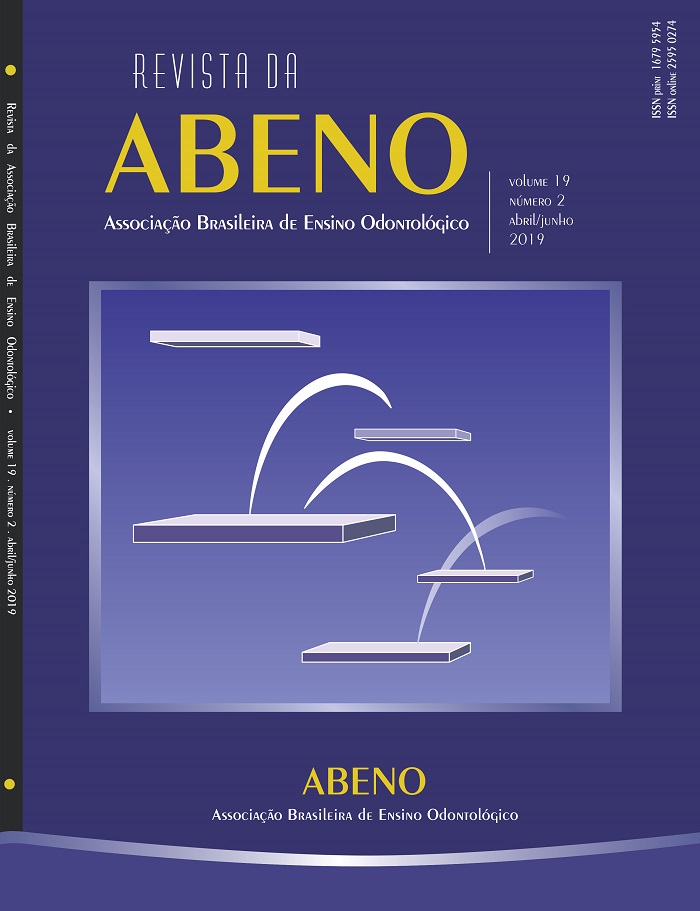Student’s perception of the implementation of the OSCE method in the Dentistry course of a private university
DOI:
https://doi.org/10.30979/rev.abeno.v19i2.790Keywords:
Educational Assessment. Dentistry. Education in Dentistry. OSCE.Abstract
The Objective Structured Clinical Examination (OSCE) is used to detect and intervene in the students’ lack of confidence in a simulated clinical condition. The OSCE assesses competences, clinical skills, knowledge, attitude, communication, and professionalism, being considered an important tool in the teaching-learning process. This context raised the need to implement the OSCE clinical competence assessment. The objective of the study was to assess the dentistry student’s perception of the OSCE method and its impact on their academic training. This study included thirty-four senior students. The data were collected using a multiple-choice questionnaire (“disagree”, “agree”, “partially agree”, “indifferent”) voluntarily answered. The chi-square test was used to analyze the data by comparing the answers of four OSCE methodology applications during the year, with a 95% (p <0.05) significance level. The difference was also significant regarding the same question in the last assessment (93.1%, p = 0.017). As for the method having contributed to their future professional practice, 93.1% (p = 0.042) of the students agreed in the last assessment of the year. Based on the analysis of questionnaire answers in the four bimesters, we concluded that the perception of the students attending the 5th year of dentistry at Positivo University is that the implementation of the OSCE method was well accepted and positive, since most of the answers indicated that the method significantly contributed to their training and provided learning opportunities.Downloads
References
Nie R, Zhu F, Meng X, Zhang H, Xie S, Wu L, Yang J, et al. Application of OSCE for Stage Assessment in Standardized Training for Oral Residents. J Dent Educ. 2018;82(9):1000-6.
Steiner-Oliveira C, Kantovitz KR, Teixeira MS, Vieira KA, Serra MD, Gambarelli, FR et al. Estudo preliminar do instrumento de avaliação clínica proposto aos alunos de graduação de Odontopediatria da Faculdade de Odontologia de Piracicaba – Unicamp. Ciênc Odontol Bras. 2006;9(1):77-86.
Logar GA, Coelho COL, Pizi ECG, Galhano GAP, Neves AP, de Oliveira LT, Bertão JMO. OSCE na avaliação clínica odontológica: relato de experiência com estudantes de graduação. Rev ABENO. 2018;18(1):15-24.
Amaral FTV, Troncon, LEA. Participação de estudantes de Medicina como avaliadores em Exame Estruturado de Habilidade Clínicas (OSCE). Rev Bras Educ Med. 2017;31(1):81-9.
Deci EL, Ryan RM. Promoting self-determined education. Scand J Educ Res. 1994;38(1):3-14.
Kupke J, Wicht MJ, Stützer H, Derman SH, Lichtenstein NV, Noack MJ. Does the use of a visualized decision board by undergraduate students during shared decision-making enhance patients’ knowledge and satisfaction? A randomised controlled trial. Eur J Dent Educ. 2013;17(1):19-25.
Manogue, M, Brown G, Foster H. Clinical assessment of dental students: values and practices of teachers in restorative dentistry. Med Educ. 2001;35(4):364- 70.
Mania TV, Vargas AMD, Ferreira EF. Inserção no mundo do trabalho odontológico: percepção de graduandos em odontologia sobre habilidades adquiridas e expectativas. Rev ABENO. 2018;18(3):148-58.
Gonçalves PVAJ, Pretti H, Teixeira KIR, Magalhães CS, Moreira NA, Peixoto RTRC. Estratégias para avaliação do desempenho clínico de estudantes de Odontologia. Rev Docência Ens Sup. 2016;6(2):223-46.
Harden RM, Gleeson FA. Assessment of clinical competence using an objective structured clinical examination (OSCE). Med Educ. 1979;13(1):41-54.
Harden RM. What is an OSCE? Med Teach.1988;10(1):19-22.
Harden, RM. Twelve tips for organizing an Objective Structured Clinical Examination (OSCE). Med Teach. 1990;12(3-4):259-64.
Lele SM. A mini-OSCE for formative assessment of diagnostic and radiographic skills at a Dental College in India. J Dent Educ. 2011;75(12):1583-9.
Park SE, Kim A, Kristiansen J, Karimbux NY. The influence of examiner type on Dental students OSCE scores. J Dent Educ. 2015;79(1):89-94.
Macluskey M, Durham J, Balmer C, Bell A, Cowpe J, Dawson L, et al. Dental student suturing skills: a multicentre trial of a checklist-based assessment. Eur J Dent Educ. 2011;15(4):244-9.
Landes C, Höfer SH, Shuebel F, Ballon A, Teiler A, Tran A,Weber A, et al. Long- term, prospective teaching effectivity of practical skills. J Craniomaxillofac Surg. 2014;42(5):97-104.
Barman, A. Critiques on the objective structured clinical examination. Ann Acad Med Singapore. 2005;34(8):478-82.
Graham R, Zubiaurre Bitzer LA, Mensah FM, Anderson OR. Dental student perceptions of the educational value of a comprehensive, multidisciplinary OSCE. J Dent Educ. 2014;78(5):694-702.
Graham R, Zubiaurre Bitzer LA, Anderson OR. Reliability and predictive validity of a comprehensive preclinical OSCE in dental education. J Dent Educ.2013;77(2):161-7.
Eberhard L, Hassel A, Baumer A, Becker F, Beck-Mubotter J, Bomicke W, et al. Analysis of quality and feasibility of an objective stuctured clinical examination. Eur J Dent Educ. 2011;15(3):172-8.
Mossey PA, Newton JP, Stirrups DR. Scope of the OSCE in the assessment of clinical skills in dentistry. Br Dent J. 2001;190(6):323-6.
Höfer SH, Schuebel F, Sader R, Landes C. Development and implementation of an objective structured clinical examination (OSCE) in CMF surgery for dental students. J Craniomaxillofac Surg. 2013;41(5):412-6.
Downloads
Published
How to Cite
Issue
Section
License
Autores que publicam nesta revista concordam com os seguintes termos:
a) Autores mantém os direitos autorais e concedem à revista o direito de primeira publicação, com o trabalho simultaneamente licenciado sob a Licença Creative Commons Attribution que permite o compartilhamento do trabalho com reconhecimento da autoria e publicação inicial nesta revista.
b) Autores têm autorização para assumir contratos adicionais separadamente, para distribuição não-exclusiva da versão do trabalho publicada nesta revista (ex.: publicar em repositório institucional ou como capítulo de livro), com reconhecimento de autoria e publicação inicial nesta revista.
c) Autores têm permissão e são estimulados a publicar e distribuir seu trabalho online (ex.: em repositórios institucionais ou na sua página pessoal) a qualquer ponto antes ou durante o processo editorial, já que isso pode gerar alterações produtivas, bem como aumentar o impacto e a citação do trabalho publicado (Veja O Efeito do Acesso Livre).






